The Winery at Iron Gate Farm
by
K.L. Sullivan
Summary: While tasting wines note the labels on the wine bottles, many of which have a small picture of tobacco leaves preserving the historical value of tobacco to this area. While most of the wine is sold from the tasting room, wines are distributed to restaurants. Debbie creates private labels for the restaurants. One of the focuses at The Winery at Iron Gate Farms is on agritourism.
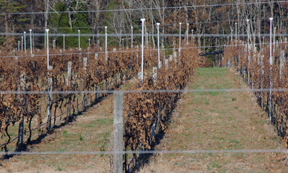 Located in the Piedmont area of North Carolina, The Winery at Iron Gate Farm is on the Haw River Valley Wine Trail. Home to North Carolina’s second woman trained winemaker, Debbie Stikeleather practiced her trade under the guidance of Linda King, North Carolina’s first woman winemaker. Debbie and her husband purchased the property in 2000. The vineyard was planted in 2001 and the first vintage was in 2003. The wine tasting room opened to the public July 1, 2004. Above the door to the winery is a sign with Steigleder 1740. It was in 1740 that three brothers from the family came from Germany. They were makers of harnesses and wagons.
Located in the Piedmont area of North Carolina, The Winery at Iron Gate Farm is on the Haw River Valley Wine Trail. Home to North Carolina’s second woman trained winemaker, Debbie Stikeleather practiced her trade under the guidance of Linda King, North Carolina’s first woman winemaker. Debbie and her husband purchased the property in 2000. The vineyard was planted in 2001 and the first vintage was in 2003. The wine tasting room opened to the public July 1, 2004. Above the door to the winery is a sign with Steigleder 1740. It was in 1740 that three brothers from the family came from Germany. They were makers of harnesses and wagons.
Debbie had driven past the property each day on her way to one of her first jobs in the 1970s. At that time, the Lynch family, whose ancestors had received the property as a land grant from King George, owned the property. Eventually the property became a tobacco farm. The Lynch family sold the farm to a man in Connecticut. Years later Debbie and her husband were able to lease it and eventually purchase the farm.
Today the property continues as a farm with other farming activities taking place including raising horses. The vineyards cover eight acres and include Merlot, Sauvignon Blanc, Cabernet Sauvignon, Chambourcin, Sangiovese, Viognier, Seyval, Tremminate and Norton. Currently, the winery bottles 3100 cases and hopes to reach 5000 cases in the future.
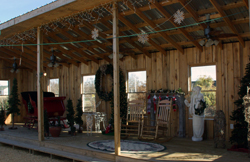
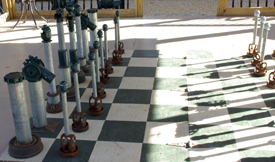 Outside of the tasting room is an outdoor stage. In late November, the stage was set with a scene for Santa, with a Christmas tree, fireplace with Christmas stockings and two rocking chairs. In the summer, the stage is for concerts. A large chess set made from large pieces of piping and other metals is located closer to the front door of the tasting room.
Outside of the tasting room is an outdoor stage. In late November, the stage was set with a scene for Santa, with a Christmas tree, fireplace with Christmas stockings and two rocking chairs. In the summer, the stage is for concerts. A large chess set made from large pieces of piping and other metals is located closer to the front door of the tasting room.
Debbie is proud of the unique netting system used to protect the vineyards from birds including robins and bluebirds. The location of the vineyard is in a migratory path and the birds can devastate the crop. In the past, the vineyard has lost many grapes due to birds. This year the Smart Net netting system was professionally installed. There are only a few of these netting systems of its kind in the United States. Even when the netting is covering the vines, workers are able to work under the net to prune, manage and harvest. Debbie was quick to note that growing grapes is the same as any other farm product. Grapes are affected by the weather, diseases and animals.
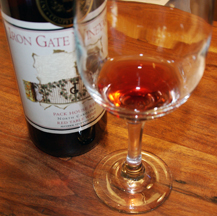 We tasted several wines while we visited with Debbie. White wines included the best selling wine 2005 Brightleaf White. This wine was blended in stainless steel. It had a fruit nose with an apricot taste and was crisp and dry. The 2004 Sauvignon Blanc had a fruit nose with citrus fruit taste and apple on the aftertaste. It was crisp and dry. The 2005 Chardonnay was a one-half oak and one half stainless steel blend. There was oak and butter on the nose. It had an apple taste and a buttery finish with a long aftertaste.
We tasted several wines while we visited with Debbie. White wines included the best selling wine 2005 Brightleaf White. This wine was blended in stainless steel. It had a fruit nose with an apricot taste and was crisp and dry. The 2004 Sauvignon Blanc had a fruit nose with citrus fruit taste and apple on the aftertaste. It was crisp and dry. The 2005 Chardonnay was a one-half oak and one half stainless steel blend. There was oak and butter on the nose. It had an apple taste and a buttery finish with a long aftertaste.
Red wines included the 2005 Pack House Red which is the most popular red wine. This wine was a blend of 70 percent Sangiovese, 15 percent Merlot and 15 percent Chambourcin. It had one percent residual sugar and was slightly sweet. It was a mild wine with red fruit tastes and very soft tannins. This is a good red for people who do not like red wines. The 2005 Merlot was aged in French oak. It had a red fruit nose and taste. It finished with red cherries and earthiness. Chambourcin, 2005 had a red fruit strawberry nose and taste. It was very mild and another good red wine for white wine drinkers. The 2006 Cabernet Sauvignon had a red stone fruit nose with a cherry fruit taste. It had earthiness on the aftertaste.
Two sweet wines were available. Country Blooming was 100 percent Riesling. It was floral with a fruity nose, fruit taste and aftertaste. Flue Fire was 50 percent Niagara and 50 percent Carlos. It was sweet but dry on the aftertaste. This wine evoked memories of Grandma’s house.
Events also play an important part at the winery. Open House events feature artisans, food and music. Murder Mystery events are offered. On weekends, seated wine tastings take place. Debbie has found these seated tastings to be very popular.
The winery also participates with North Carolina State as a research winery. This is a two-way partnership. Both the winery and the university benefit from the partnership.
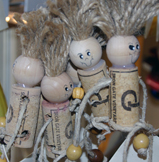
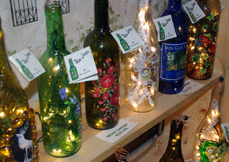 Students from a nearby high school create wonderful artistic products for the winery tasting room including “cork boys” and lovely bottle lights painted by talented students. Be sure to check out these items when you visit The Winery at Iron Gate Farm.
Students from a nearby high school create wonderful artistic products for the winery tasting room including “cork boys” and lovely bottle lights painted by talented students. Be sure to check out these items when you visit The Winery at Iron Gate Farm.
GPS: N 36° 09.063 W 079° 16.396
Visit this North Carolina Winery
 |
